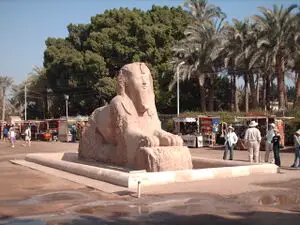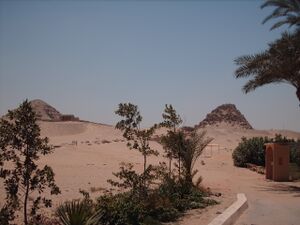How Did the Ancient City of Memphis Rise to Prominence
Ancient Egyptian Memphis was perhaps the most important city in the Nile Valley, but it is also, unfortunately, owing to high water tables and a dense population, one of the least excavated ancient Egyptian cities. Memphis served as Egypt’s political capital throughout most of pharaonic history, with the exception of Thebes being the capital in the Eleventh, Seventeenth, and Eighteenth dynasties and List/Iti-Tawy acting the political center in the Twelfth Dynasty, demonstrating that Memphis was among the most enduring and significant cities in the ancient world.
Memphis’s ascent to power happened quite quickly, probably taking place in the First Dynasty not long after the Upper and Lower Egypt were unified around 3100 BC. The kings continued to be buried in the Upper Egyptian city of Abydos, but the bureaucrats migrated north and by the end of the First Dynasty Memphis was the seat of political power in Egypt. As Memphis grew in political prominence, it also became an important religious center. Memphis became the center of the creator god, Ptah, and was also believed to have been where the creation myth is known as the “Memphite Theology” originated. The population migration into Memphis, combined with its growing religious importance, ultimately led to it becoming the largest royal necropolis in the world. The kings of the Old Kingdom used the region as their burial ground, which made it the place for nobles and other important Egyptians to be buried throughout pharaonic history.
Abydos
When Upper and Lower Egypt were unified by Narmer around 3100 BC, most of the early Egyptian elites were from southern, or Upper Egypt. The elites initially congregated in the provincial town known as Abydos, although it was inhabited since the Pre-historic period. [1] Abydos became an important location during this early point in Egypt’s history because it was a spiritual center.
Abydos was the religious center of the cult of Osiris, the god of the dead, and it was also where all of the kings of the First Dynasty and the last two kings of the Second Dynasty were interred. [2] These early kings were buried in brick chambers that were set in large pits. A solid block, known as a mastaba, was then placed over the tomb. The early kings certainly had a strong spiritual connection to Abydos, but they were pragmatic enough to know that its location was not conducive to maintaining a stable state. Abydos was too far from the popular Delta and was not much of a city itself, which meant that the early pharaohs had to look north for a new home. So, sometime in the First Dynasty, the capital moved north to Memphis, which was located at the south end of the Delta and close to what many consider the boundary between Upper and Lower Egypt.
Memphis the Political Capital
The details by which Memphis became the political capital of Egypt are somewhat cloudy. There are no extant Egyptian written sources that document when or why Memphis was built, so scholars are left to rely on a combination of Greek/classical sources and archeology. The first century BC Greek historian, Diodorus, claims that the eighth king of Egypt’s First Dynasty built Memphis. Although the eighth king is believed by Egyptologists to have been Qa’a, Diodorus referred to the ruler as “Uchoreus.” A little more than 100 years before Diodorus wrote his history, the third-century Hellenized Egyptian priest, Manetho, wrote an account of Memphis’s origins.
According to a fragment of Manetho that was later recorded in Armenian by the early Christian historian and theologian, Eusebius, Memphis was built by the second king of the First Dynasty. The fragment states:
“Athothis, his son, held the throne for 27 years. He built for himself a royal palace at Memphis, and also practices the art of medicine, writing books on the method of anatomy.” [3]
These accounts can be compared with the slightly earlier one of the fifth century BC Greek historian, Herodotus. In his account, Herodotus refers to Narmer as Min/Menes.
“The priests told me that it was Min, the first king of Egypt, who raised the dam which created Memphis. The river used to flow along the base of the sandy hills on the Libyan border, and this monarch, by damming it up at the bend about a hundred furlongs south of Memphis, drain the original channel and diverted it to a new one halfway between the two lines of the hills.” [4]
The reality is that all of the Greek sources could be factual. It certainly would have taken multiple generations to build Memphis, so it is likely that it was founded by Narmer and then added to be later First Dynasty kings. In fact, additions were constantly being made to Memphis, as with most cities in general, right up until the Greeks took control of Egypt in the fourth century BC.
Unfortunately, though, the early city is all but lost, so any reconstruction has to be based on a combination of monuments from the New Kingdom (c. 1500-1075 BC) and classical accounts such as these. The picture of early Memphis that emerges is as one of the world’s first cosmopolitan cities. The name “Memphis” is actually a Greek approximation of “Men-nefer,” which means “Goodness is established.” Memphis was also known as “Ineb Hedj Niut,” or “the City of the White Wall,” because it was known for its defensive barrier. [5] Memphis’s defensive capabilities was described in detail by Diodorus.
“Uchoreus, founded Memphis, the most renowned city of Egypt. For he chose the most favourable spot in all the land, where the Nile divides into several branches to from the ‘Delta,’ as it is called form its shape; and the result was that the city, excellently situated as it was at the gates of the Delta, continually controlled the commerce passing into upper Egypt. Now he gave the city a circumference of one hundred and fifty stades, and made it remarkably strong and adapted to its purpose by works of the following nature. Since the Nile flowed around the city and covered it at the time of inundation, he threw out a huge mound of earth on the south to serve as a barrier against the swelling of the river and also as a citadel against the attacks of enemies by land; and all around the other side he dug a large and deep lake, which, by taking up the force of the river and occupying all the space about the city except where the mound had been thrown up, gave it remarkable strength.” [6]
Memphis was alive with the hustle and bustle of government officials and scribes tallying taxes, soldiers training in their forts, workmen traveling back and forth from the necropolises, and priests doing their religious duties. All of these classes played a role in making Memphis politically important, but it was the workmen and priests who gave Memphis its added religious significance.
Memphis the Religious Center
Memphis became a religious capital at an early time, as it became known as the cult center for the creator god Ptah. The ancient Egyptians were unique among pre-modern peoples because they believed in not only multiple creation myths, but also that those myths could have equal validity and exist simultaneously. The most important creation myth in the Late Period (728-332 BC) was the “Memphite cosmogony” or “Memphite theology,” which stated that the god Ptah created all the other gods by uttering the first speech. The Memphite theology became so-called because Ptah’s cult center was in the city and because the oldest extant written copy of the myth traced its origins to Memphis. The text known as the “Shabaqa Stone” was dated to the eighth century, but it is believed to have been a copy of an Old Kingdom (c. 2686-2125 BC) original. The text describes how the gods made Upper and Lower Egypt and set Memphis, referred to as “Ptah-South-of-His-Wall,” as the capital.
“Then Horus stood over the land. He is the uniter of this land, proclaimed in the great name: Ta-tenen, South-of-his-Wall, Lor of Eternity. The sprouted the two Great Magicians upon his head. He is Horus who arose as king of Upper and Lower Egypt, who united the Two Lands in the Nome of the Wall, the place in which the Two Lands were united. Reed and papyrus were placed on the double door of the House of Ptah. That means Horus and Seth, pacified and united. They fraternized so as to cease quarreling in whatever place they might be, being united in the House of Ptah." [7]
In addition to Memphis being the home of Ptah and his cult, it also served as the largest collective necropolis in the world. Stretching from Giza in the north, the Memphite necropolis included the sites of Abusir, Saqqara, Dashur, and several smaller sites. The Great Pyramids, the sun temples of the Fifth Dynasty, the Serapeum, and the many animal necropolises of the Late Period are also part of this vast city of the dead. The practice of burying the dead on the west bank of the Nile River across from Memphis began in the Second Dynasty, [8] and with the exception of the Twelfth Dynasty and the New Kingdom, most of Egypt’s kings, nobles, and important people were interred in this region. Modern people may see Memphis as a place of death, but since the Egyptians believed in eternal life, they would have viewed the Memphite necropolis much differently.
Conclusion
Few cities in the ancient world, especially the Bronze Age Near East, were as important as Memphis, Egypt. For centuries, Memphis served as Egypt’s political capital and was also a religious center. Memphis rose to prominence after one or more kings built the city in the First Dynasty, and then it became an important religious center as the center of the Ptah cult and the largest collective necropolis in the ancient world. Memphis successfully fought off challenges by Lisht and Thebes and only fell in importance after the Greeks arrived and built Alexandria.
References
- Jump up ↑ Kemp, Barry J. Ancient Egypt: Anatomy of a Civilization. (London: Thames and Hudson, 1991), p. 77
- Jump up ↑ Arnold, Dieter. “Royal Cult Complexes of the Old and Middle Kingdoms.” In Temples of Ancient Egypt. Edited by Byron Shaffer. (Ithaca, New York: Cornell University Press, 1999), p. 40
- Jump up ↑ Manetho. Aegyptiaca. Translated by W. G. Waddell. (Cambridge, Massachusetts: Harvard University Press, 2004), Fr. 7b
- Jump up ↑ Herodotus. The Histories. Translated by Aubrey de Sélincourt. (London: Penguin, 2003), Book II, 99
- Jump up ↑ Lehner, Mark. The Complete Pyramids: Solving the Ancient Mysteries. (London: Thames and Hudson, 2001), p. 78
- Jump up ↑ Diodorus. The Library of History. Translated by C.H. Oldfather. (Cambridge, Massachusetts: Harvard University Press, 2004), Book II, 50
- Jump up ↑ Lichtheim, Miriam, ed. Ancient Egyptian Literature. Volume 1, The Old and Middle Kingdoms. (Los Angeles: University of California Press, 2006), p. 53
- Jump up ↑ Lehner, pgs. 78-82



